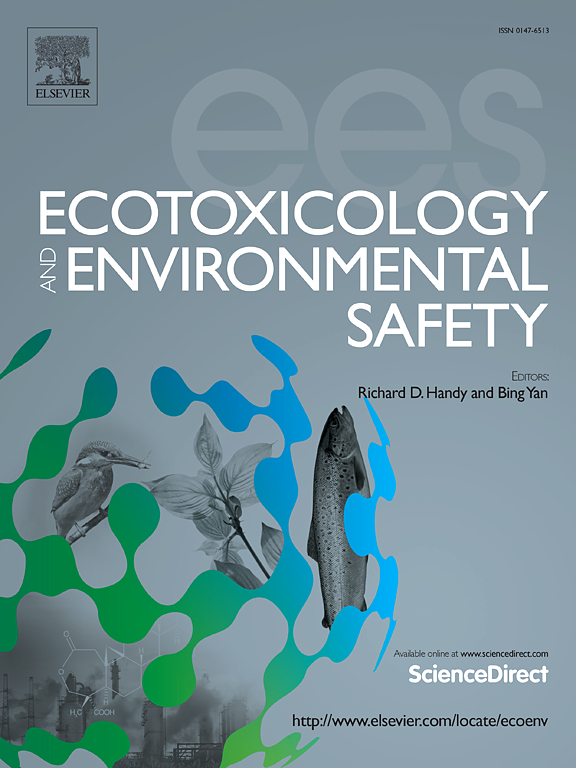农业社区父母-幼儿对二烷基磷酸代谢物和1-羟基芘的分布及其对幼儿发育表现的影响
IF 6.2
2区 环境科学与生态学
Q1 ENVIRONMENTAL SCIENCES
引用次数: 0
摘要
农药和多环芳烃(PAHs)在农业环境中的广泛存在引起了人们对生命早期接触及其对幼儿健康和发育的潜在影响的重大关注。这项横断面研究评估了泰国北部154对父母-幼儿对有机磷和多环芳烃代谢物的暴露情况,重点关注发育结果。测定尿中二烷基磷酸(DAP)代谢物和1-羟基芘(1-OHP)水平。结果显示,幼儿的总DAP代谢物几何平均水平显著高于父母,几何平均水平为24.38 µg/g肌酐,而父母的几何平均水平为17.25 µg/g肌酐。在父母和幼儿中,尿中总二甲基磷酸盐(总DMP)与1-OHP呈显著正相关(总DMP r = 0.290,1-OHP r = 0.485),表明存在共同的环境暴露。靠近农田是一个重要因素,距离越近,幼儿尿中总DMP和总DAP水平越高(总DMP的Beta值= - 19.8,95 %CI = - 37.3, - 2.3,总DAP的Beta值= - 27.5,95 %CI = - 47.7, - 7.4)。幼儿的行为,如在农田玩耍,与尿1-OHP水平显著升高有关(Beta = 121.5, 95 % CI = 8.5, 234.5)。值得注意的是,DMP水平与接受性沟通评分之间呈负相关(Beta = - 0.009, 95 % CI = - 0.018, - 0.001),表明对神经发育有潜在的不利影响。这些发现强调了农业社区幼儿对环境污染物的脆弱性,并强调需要采取有针对性的干预措施,以减少暴露风险和促进更安全的农业做法。这项研究为未来的环境卫生研究和政策制定提供了重要的见解。本文章由计算机程序翻译,如有差异,请以英文原文为准。
Distribution of dialkylphosphate metabolites and 1- hydroxypyrene in parent-toddler pairs from agricultural communities and their impacts on toddler’s developmental performance
The widespread presence of pesticides and polycyclic aromatic hydrocarbons (PAHs) in agricultural settings raises significant concerns about early-life exposure and its potential impact on toddler health and development. This cross-sectional study evaluated exposure to organophosphate and PAH metabolites among 154 parent-toddler pairs in northern Thailand, focusing on developmental outcomes. Urinary levels of dialkylphosphate (DAP) metabolites and 1-hydroxypyrene (1-OHP) were measured. Results showed that toddlers had significantly higher geometric mean levels of total DAP metabolites with a geometric mean of 24.38 µg/g creatinine compared to 17.25 µg/g creatinine in parents. A significant positive correlation was observed between the urinary levels of total dimethylphosphate (total DMP) and 1-OHP in both parents and toddlers (r = 0.290 for total DMP, r = 0.485 for 1-OHP), indicating shared environmental exposures. Proximity to farmland was a significant factor, with shorter distances associated with higher urinary total DMP and total DAP levels in toddlers (Beta = −19.8, 95 %CI = −37.3, −2.3 for total DMP, and Beta = −27.5, 95 % CI = −47.7, −7.4 for total DAP). Toddlers’ behavior, such as playing on farmland, was linked to significantly elevated urinary 1-OHP levels (Beta = 121.5, 95 % CI = 8.5, 234.5). Notably, an inverse association was found between DMP levels and receptive communication scores (Beta = −0.009, 95 % CI = −0.018, −0.001), suggesting potential adverse effects on neurodevelopment. These findings underscore the vulnerability of toddlers in agricultural communities to environmental contaminants and emphasize the need for targeted interventions to reduce exposure risks and promote safer agricultural practices. The study provides crucial insights for future research and policy development in environmental health.
求助全文
通过发布文献求助,成功后即可免费获取论文全文。
去求助
来源期刊
CiteScore
12.10
自引率
5.90%
发文量
1234
审稿时长
88 days
期刊介绍:
Ecotoxicology and Environmental Safety is a multi-disciplinary journal that focuses on understanding the exposure and effects of environmental contamination on organisms including human health. The scope of the journal covers three main themes. The topics within these themes, indicated below, include (but are not limited to) the following: Ecotoxicology、Environmental Chemistry、Environmental Safety etc.

 求助内容:
求助内容: 应助结果提醒方式:
应助结果提醒方式:


